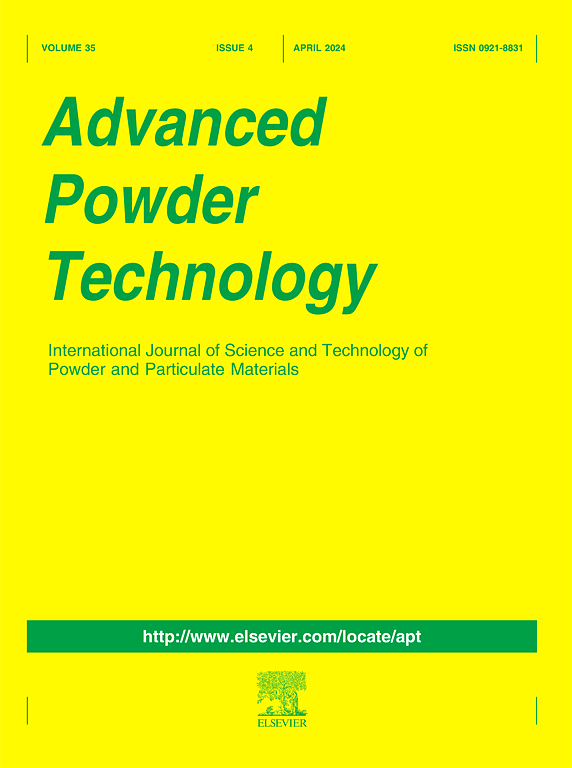烧结温度对[(Na0.5Bi0.5)TiO3]0.7-[(K0.5Bi0.5)TiO3]0.3陶瓷介电、铁电、电热和储能性能的影响
IF 4.2
2区 工程技术
Q2 ENGINEERING, CHEMICAL
引用次数: 0
摘要
在这项工作中,我们报告了烧结温度(Ts)对传统固相反应法制备的[(Na0.5Bi0.5)TiO3]0.7−[(K0.5Bi0.5)TiO3]0.3(简称0.7 nbt -0.3 kbt)陶瓷的结构、介电、铁电、电热(EC)和储能(ES)性能的影响。Rietveld精化分析证实所有样品均存在双相共存(菱形和四边形)。扫描电镜研究发现,平均晶粒尺寸随温度的增加而逐渐增大。采用间接法在303 ~ 473 K的温度范围内对ECE进行了研究。当Ts = 1140°C时,在温度为60 kVcm−1、温度为350 K时观察到的最大绝热温度变化(ΔTmax)约为0.38 K。在Ts = 1160°C时观察到最大的ES响应(Wrec ~ 0.73 J/cm3)。本研究确立了多相共存是开发新一代固态冷却装置等创新技术的可行途径。本文章由计算机程序翻译,如有差异,请以英文原文为准。
![Influence of sintering temperature on the dielectric, ferroelectric, electrocaloric, and energy storage properties of [(Na0.5Bi0.5)TiO3]0.7-[(K0.5Bi0.5)TiO3]0.3 ceramics](https://img.booksci.cn/booksciimg/2025-8/103308374211786711926.jpg)
Influence of sintering temperature on the dielectric, ferroelectric, electrocaloric, and energy storage properties of [(Na0.5Bi0.5)TiO3]0.7-[(K0.5Bi0.5)TiO3]0.3 ceramics
In this work, we report the influence of sintering temperature (Ts) on the structural, dielectric, ferroelectric, electrocaloric (EC), and energy storage (ES) properties of [(Na0.5Bi0.5)TiO3]0.7−[(K0.5Bi0.5)TiO3]0.3 (abbreviated as 0.7NBT-0.3KBT) ceramics prepared by the conventional solid-state reaction method. Rietveld refinement analysis confirmed the dual-phase coexistence (rhombohedral and tetragonal) in all the samples. The SEM study revealed a progressive increase in average grain size with Ts. The correlation between electrocaloric effect (ECE) and depolarization temperature (Td) was examined. The indirect method was used to investigate the ECE in the temperature range of 303–473 K. The maximum adiabatic temperature change (ΔTmax) of about 0.38 K was observed near 350 K at 60 kVcm−1 for Ts = 1140 °C. The maximum ES response (Wrec ∼0.73 J/cm3) was observed at Ts = 1160 °C. This study establishes multi-phase coexistence as a viable approach for developing innovative technologies such as new-generation solid-state cooling devices.
求助全文
通过发布文献求助,成功后即可免费获取论文全文。
去求助
来源期刊

Advanced Powder Technology
工程技术-工程:化工
CiteScore
9.50
自引率
7.70%
发文量
424
审稿时长
55 days
期刊介绍:
The aim of Advanced Powder Technology is to meet the demand for an international journal that integrates all aspects of science and technology research on powder and particulate materials. The journal fulfills this purpose by publishing original research papers, rapid communications, reviews, and translated articles by prominent researchers worldwide.
The editorial work of Advanced Powder Technology, which was founded as the International Journal of the Society of Powder Technology, Japan, is now shared by distinguished board members, who operate in a unique framework designed to respond to the increasing global demand for articles on not only powder and particles, but also on various materials produced from them.
Advanced Powder Technology covers various areas, but a discussion of powder and particles is required in articles. Topics include: Production of powder and particulate materials in gases and liquids(nanoparticles, fine ceramics, pharmaceuticals, novel functional materials, etc.); Aerosol and colloidal processing; Powder and particle characterization; Dynamics and phenomena; Calculation and simulation (CFD, DEM, Monte Carlo method, population balance, etc.); Measurement and control of powder processes; Particle modification; Comminution; Powder handling and operations (storage, transport, granulation, separation, fluidization, etc.)
 求助内容:
求助内容: 应助结果提醒方式:
应助结果提醒方式:


